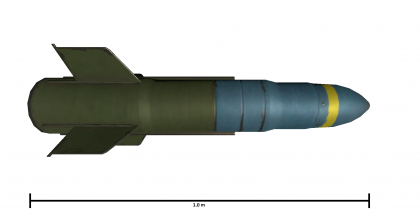Difference between revisions of "BAe Swingfire"
m (→Description) |
(→Description) |
||
| Line 2: | Line 2: | ||
[[File:WeaponImage Swingfire.png|thumb|left|420px|The Swingfire missile (scale is approximate)]] | [[File:WeaponImage Swingfire.png|thumb|left|420px|The Swingfire missile (scale is approximate)]] | ||
{{Break}} | {{Break}} | ||
| − | ' | + | Swingfire was the British Army's primary heavy anti-tank missile during the Cold War period. It was designed to allow the launcher vehicle to remain completely under cover while the gunner took a portable sighting system forward to a hidden location to guide the missiles. The missile used thrust vectoring with enough control to make a 90 degree turn immediately after firing, allowing the launcher to be positioned down a side street or behind buildings. A second sight was mounted on a periscope arrangement on the vehicle as well, allowing quick reaction shots from behind berms and hills. |
| + | |||
| + | The original versions of the 1970s offered 500 mm of penetration and used a manual guidance system, but the fleet was updated with semi-automatic guidance and then a new 800 mm warhead. This meant it could penetrate any tank from the 1960s through the 1980s, until the widespread introduction of composite and reactive armours. It is relatively slow, which allows the enemy to sometimes escape attack, but it remains highly manoeuvrable throughout its flight and can use this to attack targets behind cover. | ||
=== Vehicles equipped with this weapon === | === Vehicles equipped with this weapon === | ||
Revision as of 12:03, 19 April 2022
Contents
Description
Swingfire was the British Army's primary heavy anti-tank missile during the Cold War period. It was designed to allow the launcher vehicle to remain completely under cover while the gunner took a portable sighting system forward to a hidden location to guide the missiles. The missile used thrust vectoring with enough control to make a 90 degree turn immediately after firing, allowing the launcher to be positioned down a side street or behind buildings. A second sight was mounted on a periscope arrangement on the vehicle as well, allowing quick reaction shots from behind berms and hills.
The original versions of the 1970s offered 500 mm of penetration and used a manual guidance system, but the fleet was updated with semi-automatic guidance and then a new 800 mm warhead. This meant it could penetrate any tank from the 1960s through the 1980s, until the widespread introduction of composite and reactive armours. It is relatively slow, which allows the enemy to sometimes escape attack, but it remains highly manoeuvrable throughout its flight and can use this to attack targets behind cover.
Vehicles equipped with this weapon
General info
Tell us about the tactical and technical characteristics of the bomb.
Effective damage
Describe the type of damage produced by this type of bomb (high explosive, splash damage, etc)
Comparison with analogues
Give a comparative description of bombs that have firepower equal to these type of weapons.
Usage in battles
Describe situations when you would utilize this bomb in game (vehicle, pillbox, base, etc)
Pros and cons
Summarize and briefly evaluate the weaponry in terms of its characteristics and combat effectiveness. Mark pros and cons as a list.
Pros:
Cons:
History
Examine the history of the creation and combat usage of this weapon. If the historical reference turns out to be too big, take it to a separate article, taking a link to an article about the vehicle and adding a block "/ History" (example: https://wiki.warthunder.com/(weapon-name)/History) and add a link to it here using the main template. Be sure to reference text and sources by using <ref>, as well as adding them at the end of the article.
Media
An excellent addition to the article would be a video guide, as well as screenshots from the game and photos.
See also
Links to the articles on the War Thunder Wiki that you think will be useful for the reader, for example:
- reference to the article about the variant of the weapon;
- references to approximate analogues by other nations and research trees.
External links
Paste links to sources and external resources, such as:
- topic on the official game forum;
- encyclopedia page on the weapon;
- other literature.




